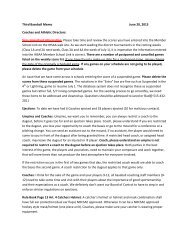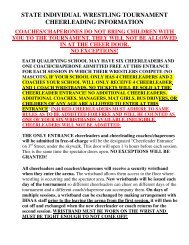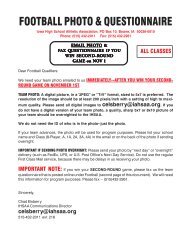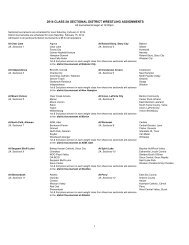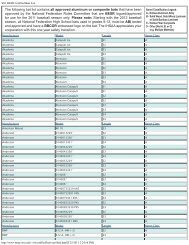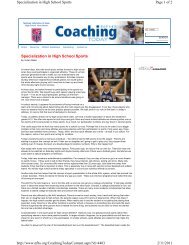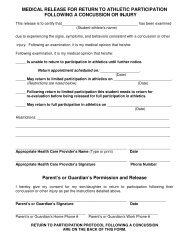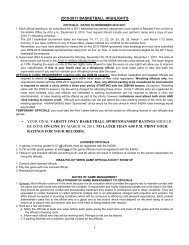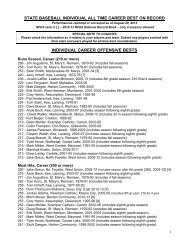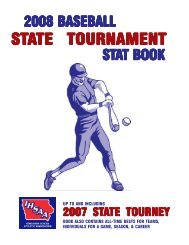Scorer Instructions and Duties
Scorer Instructions and Duties
Scorer Instructions and Duties
Create successful ePaper yourself
Turn your PDF publications into a flip-book with our unique Google optimized e-Paper software.
INSTRUCTIONS TO AND DUTIES OF THE SCORER<br />
FOR BASKETBALL GAMES<br />
RULES COVERAGE:<br />
Rule 2-4-3: The referee designates the official scorebook <strong>and</strong> the official<br />
scorer.<br />
Rule 2-11: The duties <strong>and</strong> responsibilities of the official scorer are indicated.<br />
In case of doubt, signal the floor official as soon as conditions<br />
permit to verify the official’s decision.<br />
The rules committee strongly recommends that only the official scorer<br />
wear a black-<strong>and</strong>-white striped garment <strong>and</strong> the official scorer <strong>and</strong><br />
timer be seated next to each other. The scorer’s location at the scorer’s<br />
<strong>and</strong> timer’s table must be clearly marked with an “x.”<br />
RESPONSIBILITY:<br />
The scorer’s responsibility is so great that floor officials must establish<br />
the closest cooperation <strong>and</strong> underst<strong>and</strong>ing with them. The scorer must<br />
be accurate.<br />
EQUIPMENT:<br />
Scorebook, pencils, possession arrow <strong>and</strong> signaling device with sound<br />
different from that of the timer. The scorebook must be available for<br />
inspection at the table from 10 minutes prior to game time until the<br />
referee has approved the final score.<br />
BEFORE THE GAME:<br />
1. Ten minutes before scheduled game time, the scorer shall be supplied<br />
with each team’s roster <strong>and</strong> numbers.<br />
2. Ten minutes before scheduled game starting time, the scorer shall<br />
be supplied with the starting lineup.<br />
3. Notify the referee if either list is not submitted on time or is altered<br />
after time specified.<br />
4. If there are discrepancies, notify the referee before the ball is<br />
tossed.<br />
5. Have coach sign that lineup is correct.<br />
DURING INTERMISSIONS:<br />
1. Either the official scorer or a delegated assistant must be at the<br />
scorer’s table with the official scorebook at all times.<br />
2. Verify the lineup after all intermissions <strong>and</strong> notify either floor<br />
official if a player, who has not reported, has entered the court.<br />
DURING THE COURSE OF THE GAME:<br />
1. The nonofficial scorers should check each entry with the official<br />
scorebook.<br />
2. The scorers should:<br />
a. Announce to each other <strong>and</strong> record the total running score.<br />
b. Announce the name <strong>and</strong> number of the player who scores.<br />
c. Verify the scoreboard score.<br />
d. Compare the summary of individual scores with the total<br />
running score at the end of each half.<br />
e. Exchange the name <strong>and</strong> number of the player committing a<br />
foul <strong>and</strong> indicate the total fouls charged to the player.<br />
f. Be responsible for the alternating-possession arrow.<br />
g. Record warnings reported by an official.<br />
3. In case of controversy, the record of the official scorebook is<br />
accepted unless the referee has knowledge which permits him or<br />
her to rule otherwise.<br />
SCORING: (Use the following recommended symbols)<br />
1. P for personal foul, followed by proper numeral indicating number<br />
of personal fouls charged to player as P 1 , P 2 , etc., or cross out<br />
appropriate number.<br />
2. T for technical foul (direct or indirect on coach).<br />
3. Successful field goal: figure 2 or 3.<br />
4. Free-throw attempt:<br />
5. Successful free throw:<br />
6. Two or three free throws awarded:<br />
7. First of one-<strong>and</strong>-one:<br />
First made, bonus awarded:<br />
Bonus free throw made:<br />
8. Recordthenumberofchargedtime-outs(who/when)foreachteam.<br />
9. Check the scoreboard often <strong>and</strong> have the progressive team totals<br />
available at all times. Points scored in the wrong basket are never<br />
credited to a player, but are credited to the team in a footnote.<br />
Points awarded for basket interference or goaltending by the<br />
defense are credited to the shooter. When a live ball goes in the<br />
basket, the last player who touched the ball causes it to go there.<br />
NOTIFY THE NEARER OFFICIAL WHEN:<br />
1. The bonus penalty is in effect for the seventh, eighth <strong>and</strong> ninth<br />
team foul in each half. The bonus display indicates a second free<br />
throw is awarded for all common fouls (other than player-control)<br />
if the first free throw is successful. The proper bonus panel, such<br />
as (H for home <strong>and</strong> V for visitor) shall be displayed after the<br />
penalty for the sixth team foul has been administered. Another<br />
method is to activate a light or device nearest the basket of the<br />
team which is to receive the bonus.<br />
2. The tenth team foul occurs each half. Thereafter, the bonus<br />
(second free throw) is awarded for a common foul (except playercontrol)<br />
whether or not the first is successful.<br />
3. Any player is charged with his or her fifth foul (personal or tech -<br />
nical), the second technical foul is charged to any team member,<br />
bench personnel, directly to the head coach, or the third technical<br />
foul is charged to the head coach.<br />
4. Either team has been granted its allotted charged time-outs or an<br />
excess time-out.<br />
5. The ball is dead or in control of offending players team if:<br />
a. Player has not reported.<br />
b. Player’s number changed.<br />
c. Player is illegally in game.<br />
6. The ball is dead, if there is a score dispute or doubt about an<br />
official’s decision.<br />
7. Any player enters while wearing an illegal number.<br />
8. The ball is dead <strong>and</strong> the clock is stopped or running, if the coach<br />
requests that a correctable error as in 2-10, or a timing, scoring<br />
or alternating-possession mistake be prevented or rectified.<br />
SUBSTITUTIONS:<br />
1. A substitution may be made when the ball is dead <strong>and</strong> time is out.<br />
A player who has been withdrawn may not re-enter before the<br />
next opportunity to substitute after the clock has been started<br />
properly following the player’s replacement.<br />
2. A substitute who is entitled <strong>and</strong> ready to enter must report to the<br />
official scorer. However, substitutions between halves shall be<br />
made to the official scorer by the substitute(s) or a team representative<br />
prior to the 15-second warning.<br />
3. Following a time-out or intermission, the substitute must report<br />
or be in a position to report prior to the warning signal.<br />
4. A substitute may enter the court only when beckoned <strong>and</strong> must<br />
do so at once.<br />
5. If a substitute reports to enter for a designated jumper or free<br />
thrower, the substitute may not enter until the next dead ball <strong>and</strong><br />
time is out.<br />
6. A substitute may not be beckoned, if multiple free throws are<br />
awarded, until the last throw is to be attempted or the final throw<br />
is successful (unless a player has been directed to leave the game<br />
by an official).<br />
7. A substitute may replace a designated starter in case of illness or<br />
injury or to attempt a technical-foul free throw.<br />
It is not permissible for a substitute to replace a designated jumper, or<br />
a free thrower when the free throw is for a personal foul, unless such<br />
jumper or free thrower is disqualified or injured. The scorer should not<br />
signal after the free thrower or thrower has been h<strong>and</strong>ed the ball or the<br />
ball is at the disposal of such player or team or until the official has<br />
completed reporting a foul.<br />
2010
INSTRUCTIONS TO AND DUTIES OF THE TIMER<br />
FOR BASKETBALL GAMES<br />
RULES COVERAGE:<br />
Rule 2-4-2: The referee shall designate the official timepiece <strong>and</strong> its<br />
operator.<br />
Rule 2-12: <strong>Duties</strong> <strong>and</strong> responsibilities of the timer are indicated. An<br />
efficient timer will carefully study these sections <strong>and</strong> become thoroughly<br />
familiar with all their aspects. The timer shall sound a warning<br />
signal 15 seconds before the expiration of an intermission, a time-out<br />
(60- or 30-second) <strong>and</strong> the 20-second interval to replace a disqualified,<br />
injured or player directed to leave the game. The timer shall also signal<br />
when the time has expired for an intermission, a charged time-out or a<br />
replacement interval.<br />
EQUIPMENT:<br />
Electric clock timer <strong>and</strong> one stopwatch, or a table-clock timer <strong>and</strong> one<br />
or two stopwatches. A gong, loud siren or electric air horn to signal the<br />
end of playing time. When present, a red/LED light is permitted to end<br />
a quarter or extra period; otherwise, the audible signal ends the quarter<br />
or extra period.<br />
BEFORE THE GAME:<br />
1. The official timer should ascertain the game starting time <strong>and</strong><br />
suggest that the referee <strong>and</strong> coaches synchronize their watches.<br />
2. Review the official signals for starting the clock, time-out, a foul<br />
or violation.<br />
3. Notify the scorer 10 minutes prior to the starting time.<br />
TIMING REGULATIONS:<br />
1. Playing time shall be:<br />
a. For teens of high school age — four quarters of eight minutes<br />
each with intermissions of one minute after the first <strong>and</strong> third<br />
quarters <strong>and</strong> 10 minutes between halves. Halftime may be<br />
extended to a maximum of 15 minutes upon proper notification.<br />
b. For teams younger than in (a) — four quarters of six minutes<br />
each with intermissions same as for (a).<br />
2. Overtime Play:<br />
a. If the score is tied at the end of the second half, play shall<br />
continue without change of baskets for one or more extra<br />
periods, with a one-minute intermission before each.<br />
b. The length of each extra period shall be four minutes (or half<br />
the time of a regulation quarter for non-varsity contests).<br />
c. As many such extra periods as are needed to break the tie shall<br />
be played. Game ends, if, at end of any extra period, the score<br />
is not tied.<br />
d. Extra periods are an extension of the fourth quarter.<br />
3. A time-out charged to a team is of either 60-seconds or 30-second<br />
duration unless both teams are ready to resume play sooner.<br />
4. No time-out is charged to a team when:<br />
a. The floor official grants a player’s request because of displaced<br />
eyeglasses or lens.<br />
b. A correctable error as in 2-10, or a timing, scoring or alternating<br />
possession mistake has been prevented or rectified.<br />
5. The sounding of the scorer’s signal or game horn does not cause<br />
the game timepiece to be stopped.<br />
START THE OFFICIAL TIMEPIECE WHEN:<br />
1. A tossed ball is legally tapped when play is started by a jump.<br />
2. The ball touches a player on the court during a throw-in (if clock<br />
has been stopped).<br />
3. An official signals “start the clock.” If he or she neglects to do so,<br />
the official timepiece should be started unless an official specifically<br />
signals that it should not be started.<br />
4. The ball touches or is touched by a player on the court provided<br />
the ball is to remain live if the free throw is missed. In these cases,<br />
the official will give the start-the-clock signal, but if he or she<br />
neglects to do so, the official timepiece should be started when it<br />
is apparent the ball touches a player <strong>and</strong> is to remain live.<br />
STOP THE OFFICIAL TIMEPIECE WHEN:<br />
1. Any period ends.<br />
2. An official gives a time-out signal. The official will order time-out<br />
when:<br />
a. A foul is called by holding h<strong>and</strong> with fingers closed at arm’s<br />
length above head.<br />
b. A jump/held ball is declared by giving the jump-ball signal<br />
(holding thumbs up at shoulder height away from body <strong>and</strong><br />
motioning upward with both arms extended).<br />
c. A violation occurs by giving the time-out signal (holding h<strong>and</strong><br />
with fingers extended at arm’s length above head) after which<br />
the proper violation signal is given.<br />
d. There is to be a charged time-out, or an official’s time-out for a<br />
technical foul, or other stoppage indicated by a floor official<br />
who holds a h<strong>and</strong> at arm’s length above the head with fingers<br />
extended.<br />
NEAR THE END OF PLAYING TIME:<br />
1. If a watch is being used as the official timepiece, place it so that<br />
the timer may see it <strong>and</strong> the ball. The watch must be stopped the<br />
instant the signal ending the game is sounded.<br />
2. When a timing device other than a watch is the official timepiece,<br />
the timer must assist in determining the position of the ball when<br />
time expires.<br />
3. Some timers, in order to avoid misunderst<strong>and</strong>ing concerning the<br />
position of the ball when time expires, have one person watch the<br />
official timepiece <strong>and</strong> count aloud 10 - 9 - 8 - 7, etc., while another<br />
person watches the ball <strong>and</strong> notes its position at the exact<br />
moment time expires.<br />
4. If a quarter or extra period ends <strong>and</strong>:<br />
a. The timer has been unable to make an official hear the signal,<br />
the timer must immediately notify the official.<br />
b. The timing signal fails or is not heard by an official, the timer<br />
must be prepared to advise the referee as to whether the ball<br />
was in flight when time expired, or whether a foul occurred<br />
before or after the period had ended.<br />
c. The timing signal is not heard by the officials, testimony of the<br />
timer may determine whether a score shall count or a foul shall<br />
be charged, unless the referee has information which would<br />
alter the situation.<br />
2010



